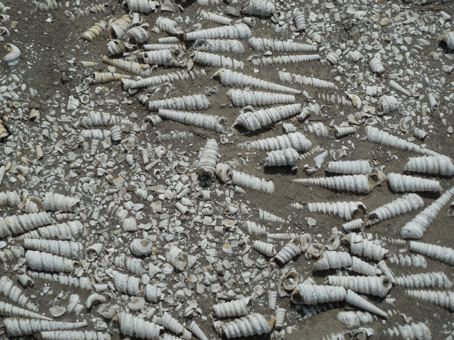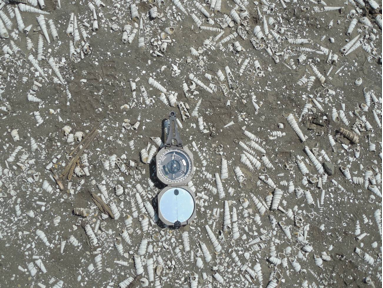This lesson plan was developed as part of the 2012-2016 Great American Biotic Interchange Research Experiences for Teachers Project (GABI RET).
By Stefanie Brown – Branciforte Middle School
Intended Audience
Middle School
Time Frame
60-75 minutes
Standards
NGSS ETS1-2 Engineering Design
California State Standards: Biological Evolution 3 a, c, and d.
Resources & Materials
Fossils collected at the Gatun formation site, student copies of Common Fossils of the Gatun Formation, hand lens, data sheet.
Guiding Questions
Students will be asked to explain the compass orientation of the turret fossils, why these fossils might have been discovered in such abundance, and how the fossils compare to modern mollusk shells.
Key Academic and/or Scientific Language
Students will need to understand compass orientation, isthmus, and scientific nomenclature such as genus and species.
Objectives
Students will gain an understanding of Gatun formation turret fossils and their relationship to the formation of the Isthmus of Panama, as well as a greater understanding of the comparative anatomy with modern mollusk shells.
Assessments
Students will complete their Activity Data sheet analysis of the Gatun formation activity. Teacher will use this to assess students’ understanding of the lesson.
Teaching phase
Introduction:
Provide students with a copy of the Guide to Common Fossils of the Gatun formation. Show pictures of the turret fossils taken on location at the Gatun formation site (see below) and ask students what they observe from the photo, specifically noting the orientation of the turret fossils. After the students have written down their observations, they will share these observations with their lab partners.
Teacher will share a brief history of the Gatun formation and refer to the guide which shows that the fossils were from 11.5 to 8.5 million years ago. Teacher will fill in more details about Gatun formation using power point and inquiry questions relating to the formation of the isthmus and the Great American Biotic Interchange.
Lab Activity:
Next, students will begin their hands-on activity. In groups students use hands lens to investigate size, shape and type of turret fossil species found at each lab station.
Students will sketch their observations and include measurements noted of all dimensions. They will use the Gatun fossil guide to key out which type of species they think is in their station’s section. Students will rotate through the different stations.
Part 2:
They will compare the fossils to modern shells using similar techniques of scientific observation and inquiry.
At the conclusion the group’s “reporter” will be selected to share each group’s findings from this Lab activity.
Extension/Closure:
Students will be asked to observe shells on the beach at the next time they go. Which ones do they find most often and why do they think these remain intact? How does this connect to the fossils of the Gatun formation?
Reading | Writing | Speaking | Listening Strategies
Students are engaging all four strategies throughout the lesson as they document their observations, share these orally with their group and partners, and listen to others sharing their ideas.
Learning Progression
Students will start with the introduction and they move into the lab activity with the closure activity at the end.

